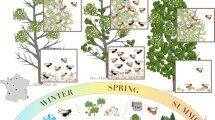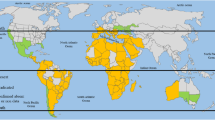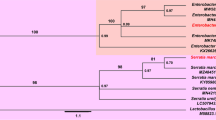Abstract
The effect of relative humidity on egg hatch success for Iphiseius degenerans, Neoseiulus californicus and N. cucumeris was described by a binomial model with a parallel slope. The shape of the response differed for Phytoseiulus persimilis and a model with separate parameters gave a significantly better fit. Fitted response curves showed that I. degenerans, N. cucumeris, N. californicus and P. persimilis were ranked by decreasing tolerance to low humidity, with egg mortalities of <0.5, 3, 12 and 16% respectively at 75–80% RH at 20 °C. Egg stage duration for I. degenerans and N. cucumeris was unaffected over the range 60–82% RH. For N. californicus and P. persimilis egg duration was significantly longer at 60 and 70% than for either 82 or 90% RH. No effect of relative humidity was found on the mean life span of adult females when food was available continuously to the mites. N. californicus lived significantly longer (58 days after the first egg was laid) than the other species. No significant difference was observed in mean life span between adult females of I. degenerans and N. cucumeris (25 and 28 days respectively). The mean life span of adult female P. persimilis (19 days) was significantly shorter than the other species. In the absence of both food and water, the survival of adult female mites was reduced to 2–4 days. Survival time was at least doubled when free water was available in the absence of food. Mean survival of adult female mites with water but without food was 10 days for N. cucumeris, 18 days for N. californicus, 6 days for P. persimilis and 4 days for I. degenerans. Survival of adult female N. cucumeris and N. californicus was increased significantly, to 20 and 22 days respectively, when fungal hyphae were present along with water but in the absence of other food.
Similar content being viewed by others
References
Abou-Awad B.A., Reda A.S. and Elsawi S.A. 1992. Effects of artificial and natural diets on the development and reproduction of two phytoseiid mites Amblyseius gossipi and Amblyseius swirskii (Acari: Phytoseiidae). Insect Sci. Appl. 13: 441–445.
Baier B. 1991. Relative humidity-a decisive factor for the use of oligophagous predatory mites in pest control. In: Dusa´bek F. and Bukuva V. (eds) Modern Acarology. Vol. 2. Academia, Prague and SPB Academic Publishing, The Hague, pp. 661–665.
Bakker F.M., Klein M.E., Mesa N.C. and Braun A.R. 1993. Saturation deficit tolerance spectra of phytophagous mites and their phytoseiid predators on cassava. Exp. Appl. Acarol. 17: 97–113.
Blümel S. and Walzer A. 2002. Efficacy of different release strategies of Neoseiulus californicus McGregor and Phytoseiulus persimilis Athias Henriot (Acari: Phytoseiidae) for the control of two spotted spider mite (Tetranychus urticae Koch) on greenhouse cut roses. Syst. Appl. Acarol. 7: 35–48.
Castagnoli M. and Simoni S. 1991. Influenza della temperatura sull'incremnto delle populazioni di Amblyseius californicus (McGregor) (Acari: Phytoseiidae). Redia 74: 621–640.
Chant D.A. 1959. Phytoseiid mites (Acarina Phytoseiidae). Part I. Bionomics of seven species in southeastern England. Can. Entomol. 91 (Suppl. 12): 5–44.
Croft B.A., Messing R.H., Dunley J.E. and Strong W.B. 1993. Effects of humidity on eggs and immatures of Neoseiulus fallacis, Amblyseius andersoni, Metaseiulus occidentalis and Typlodromus pyri (Phytoseiidae): implications for biological control on apple, caneberry, strawberry and hop. Exp. Appl. Acarol. 17: 451–459.
de Moraes G.J. and McMurtry J.A. 1981. Biology of Amblyseius citrifolius (Denmark and Muma) (Acarina: Phytoseiidae). Hilgardia 49: 1–29.
Ferro D.N. and Chapman R.B. 1979. Effects of different constant humidities and temperatures on two spotted spider mite egg hatch. Environ. Entomol. 8: 701–705.
Ferro D.N. and Southwick E.E. 1984. Microclimates of small arthropods: estimating humidity within the leaf boundary layer. Environ. Entomol. 13: 926–929.
Flechtmann C.H.W. and McMurtry J.A. 1992a. Studies on how phytoseiid mites feed on spider mites and pollen. Int. J. Acarol. 18: 157–162.
Flechtmann C.H.W. and McMurtry J.A. 1992b. Studies of cheliceral and deutosternal morphology of some Phytoseiidae (Acari: Mesostigmata) by scanning electron microscopy. Int. J. Acarol. 18: 163–169.
Gaede K. 1992. On the water balance of Phytoseiulus persimilis A.-H. and its ecological significance. Exp. Appl. Acarol. 15: 181–198.
GenStat 2000. GenStat for Windows. Release 4.2. VSN International Ltd., Oxford, UK.
Gillespie D.R. and Quiring D.J.M. 1994. Reproduction and longevity of the predatory mite, Phytoseiulus persimilis (Acari: Phytoseiidae) and its prey, Tetranychus urticae (Acari: Tetranychidae) on different host plants. J. Entomol. Soc. Brit. Columbia 91: 3–8.
Gilstrap F.E. and Friese D.D. 1985. The predatory potential of Phytoseiulus persimilis, Amblyseius californicus and Metaseiulus occidentalis (Acarina: Phytoseiidae). Int. J. Acarol. 11: 163–168.
Holtzer T.O., Norman J.H., Perring T.M., Berry J.S. and Heinz J.C. 1988. Effects of microenvironment on the dynamics of spider mite populations. Exp. Appl. Acarol. 4: 247–264.
Kropczynńka-Linkiewicz 1971. Studies on the feeding of four species of phytoseiid mites (Acarina: Phytoseiidae). In: Daniel M. and Rosický B. (eds) Proceedings of the Third International Congress on Acarology. Academia, Czechoslovak Academy of Sciences, Prague, pp. 225–227.
McMurtry J.A. and Croft B.A. 1997. Life-styles of phytoseiid mites and their roles in biological control. Annu. Rev. Entomol. 42: 291–321.
O'Brien F.E.M. 1948. The control of humidity by saturated salt solutions. J. Sci. Instrum. 25: 73–76.
Overmeer W.P.J. 1985. Rearing and handling.In: Helle W. and Sabelis M.W. (eds) Spider Mites: Their Biology, Natural Enemies and Control, Vol. 1B. Elsevier, Amsterdam, The Netherlands, pp 161–170.
Peterson A. 1964. Entomological Techniques. Edwards Brothers, Michigan, USA.
Ramakers P.M.J. and van Lieburg M.J. 1988. Start of commercial production and introduction of Amblyseius mckenziei Sch. and Pr. (Acarina: Phytoseiidae) for the control of Thrips tabaci Lind. (Thysanoptera: Thripidae) in glasshouses. Med. Fac. Landbouww. Rijksuniv. Gent 47 (2): 541–545.
Rencken I.C. and Pringle K.L. 1998. Development of Amblyseius cucumeris (McGregor) (Acarina: Phytoseiidae), a predator of tetranychid mites, at three temperatures. Afr. Entomol. 6: 41–45.
Sabelis M.W. 1981.Biological control of two-spotted spider mites using phytoseiid predators. Part I. Modelling the predator-prey interaction at the individual level. Agric. Res. Rep.Agric. Univ., Wageningen 910: 1–242.
Sabelis M.W. and Janssen A. 1994. Evolution of life-history patterns in the Phytoseiidae. In: Houck M.A. (ed.) Mites, Ecological and Evolutionary Analyses of Life-history Patterns. Chapman and Hall, New York, pp. 70–98.
Sabelis M.W. and Nagelkerke C.J. 1993. Sex allocation and pseudoarrhenotoky in phytoseiid mites. In: Wrensch D.L. and Ebbert M.A. (eds) Evolution and Diversity of Sex Ratio in Insects and Mites. Chapman and Hall, New York, pp. 512–541.
Schausberger P. 1998. The influence of relative humidity on egg hatch in Euseius finlandicus, Typhlodromus pyri, and Kampimodromus aberrans (Acari, Phytoseiidae). J. Appl. Ent. 122: 497–500.
Schausberger P. and Walzer A. 2001. Combined versus single species release of predaceous mites: predator-predator interactions and pest suppression. Biol. Control 20: 269–278.
Shipp J.L. and van Houten Y.M. 1997. Influence of temperature and vapour pressure deficit on survival of the predatory mite Amblyseius cucumeris (Acari: Phytoseiidae). Environ. Entomol. 26: 106–113.
Skirvin D.J., de Courcy Williams M. and Fenlon J. 1999. Individual-based models for biological control in ornamentals; a framework for the future. Aspects of Applied Biology 55, Information Technology for Crop Protection, pp. 73–79.
Takahashi F. and Chant D.A. 1994. Adaptive strategies in the genus Phytoseiulus Evans (Acari: Phytoseiidae). II. Survivorship and reproduction. Int. J. Acarol. 20: 87–97.
van Dinh N., Sabelis M.W. and Janssen A.J. 1988. Influence of humidity and water availability on the survival of Amblyseius idaeus and A. anonymus (Acarina: Phytoseiidae). Exp. Appl. Acarol. 4: 27–40.
van Haren R.J.F., Steenhuis M.M., Sabelis M.W. and de Ponti O.M.B. 1987. Tomato stem trichomes and dispersal success of Phytoseiulus persimilis relative to its prey, Tetranychus urticae. Exp. Appl. Acarol. 3: 115–121.
van Houten Y.M., van Rijn P.C.J., Tanigoshi L.K., van Stratum P. and Bruin J. 1995. Preselection of predatory mites to improve year-round biological control of western flower thrips in greenhouse crops. Ent. Exp. Appl. 74: 225–234.
van Rijn P.C.J. and Tanigoshi L.K. 1999a. Pollen as food for the predatory mites Iphiseius degenerans and Neoseiulus cucumeris (Acari: Phytoseiidae): dietary range and life history. Exp. Appl. Acarol. 23: 785–802.
van Rijn P.C.J. and Tanigoshi L.K. 1999b. The contribution of extrafloral nectar to survival and reproduction of the predatory mite Iphiseius degenerans on Ricinus communis. Exp. Appl. Acarol. 23: 281–296.
Walzer A. and Schausberger P. 1999. Cannibalism and interspecific predation in the phytoseiid mites Phytoseiulis persimilis and Neoseiulus californicus: predation rates and effects on reproduction and juvenile development. BioControl 43: 457–468.
Walzer A., Blümel S. and Schausberger P. 2001. Population dynamics of interacting predatory mites, Phytoseiulis persimilis and Neoseiulus californicus, held on detached bean leaves. Exp. Appl. Acarol. 25: 731–743.
Winston P.W. and Bates D.H. 1960. Saturated solutions for the control of humidity in biological research. Ecology 41 (1): 232–237.
Zaher M.A. and Shehata K.K. 1971. Biological studies on the predator mite Typhlodromus pyri Sch. (Acarina Phytoseiidae) with the effect of prey and non prey substances. Z. Agnew. Entomol. 64: 389–394.
Zemek R. and Prenerová E. 1997. Powdery mildew (Ascomycotina: Erysiphales)-an alternative food for the predatory mite Typhlodromus pyri Scheuten (Acari: Phytoseiidae). Exp. Appl. Acarol. 21: 405–414.
Zhang Z.-Q. 1995. Variance and covariance of ovipositional rates and development rates in the phytoseiidae (Acari: Mesostigmata): a phylogenetic consideration. Exp. Appl. Acarol. 19: 139–146.
Author information
Authors and Affiliations
Corresponding author
Rights and permissions
About this article
Cite this article
De Courcy Williams, M.E., Kravar-garde, L., Fenlon, J.S. et al. Phytoseiid mites in protected crops: the effect of humidity and food availability on egg hatch and adult life span of Iphiseius degenerans, Neoseiulus cucumeris, N. californicus and Phytoseiulus persimilis (Acari: Phytoseiidae). Exp Appl Acarol 32, 1–13 (2004). https://doi.org/10.1023/B:APPA.0000018170.46836.11
Issue Date:
DOI: https://doi.org/10.1023/B:APPA.0000018170.46836.11




